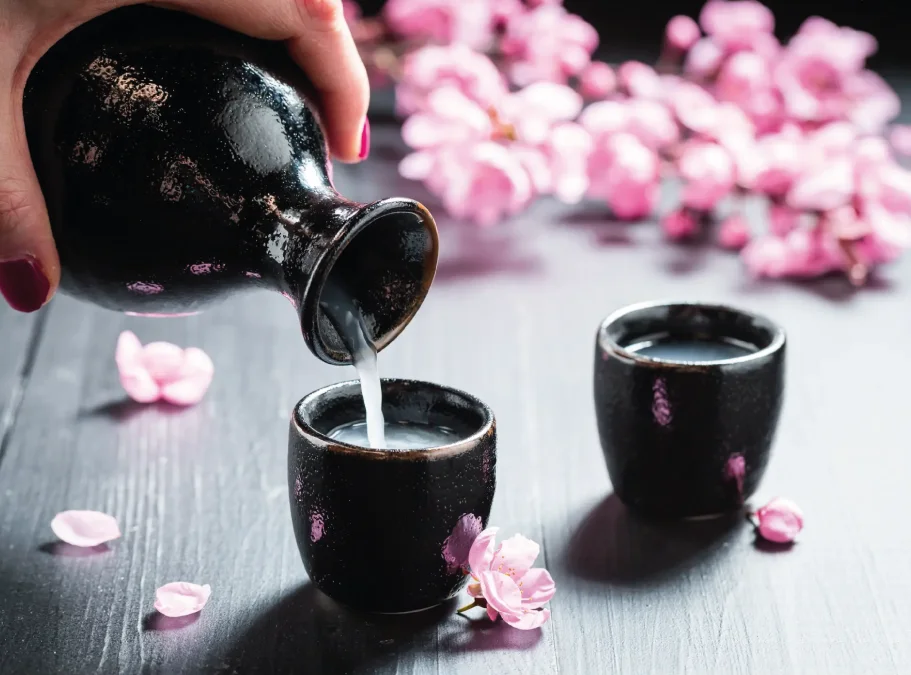Japan’s famed alcoholic drink is a fusion of intricate brewing techniques and historical depth. Exploring its origins and varieties, our guide offers insight into the fine art of enjoying sake, the traditional Japanese drink that is capturing the world’s fascination.
Key Takeaways:
- Sake, or ‘Nihonshu’, is a traditional Japanese beverage with a simple recipe but a complex two-stage fermentation process, integral to Japanese culture and enjoyed in various ways including warmed or chilled.
- The brewing of sake is a labour-intensive art that requires a master brewer, known as Toji, to oversee a meticulous process from rice polishing to bottling, with modern innovations continuously evolving the craft.
- Sake holds a significant place in both religious ceremonies and social gatherings in Japan, and its global popularity is rising, with its cultural significance celebrated worldwide on International Sake Day, each year on 1st October and during UK National Sake Week 15-21 April
Exploring Sake: Japan’s Signature Beverage
Delve into the world of sake, a quintessential Japanese drink deeply embedded in the cultural fabric for countless years. This distinctive beverage derived from rice has uniquely cemented its place within the rituals and communal customs of Japan, becoming an integral part of their societal traditions.
The Basics of Sake
The crafting of sake, or ‘Nihonshu’ as it is called in Japanese, represents a complex art form. Despite its straightforward recipe comprising just four basic ingredients—rice, water, koji-kin (Aspergillus spores), and yeast—the actual production involves a complicated two-phase fermentation technique. This intricate process is instrumental in producing the traditional Japanese drink
Types of Sake
Sake provides a delightful and varied selection that caters to different preferences. The assortment ranges broadly due to the variety in rice polishing ratios and whether brewer’s alcohol is added, accommodating and serving the diverse tastes of its consumers.
Each category of sake, ranging from Daiginjo-shu to Futsushu, delivers its own distinctive taste, experience and character.
How to Enjoy Sake
Indulging in the experience of sake involves attention to serving temperature, complementing it with appropriate cuisine, and appreciating its cultural importance. From enjoying a robust Junmai gently heated to enhance the deep flavours derived from rice, to relishing a cooled Daiginjo that accentuates its subtle fruity essence, each tasting of sake offers an encounter worth cherishing.
The Art of Sake Brewing
Sake brewing is a distinctive procedure distinguished by its method called multiple parallel fermentation. This complex process, occurring within a single tank, involves the concurrent transformation of starch into glucose and then from glucose into alcohol. It’s the result of this particular technique that differentiates sake from any other alcoholic beverages around the world.
From Rice to Sake
Creating sake involves an intricate and intensive process, starting from the beginning of the deliberate selection to the thorough preparation of specialised sake rice. This transformation from a simple grain into a refined cup of sake embodies the craftsmanship and relentless commitment of the brewers who meticulously manage every phase, including:
- Rice polishing
- Rinsing and immersing the rice
- Steaming of rice
- Cooling down and dispersal of steamed rice
- Cultivating koji (rice mold)
- The fermentative stage
- Squeezing out liquid contents
- Heating for preservation purposes.
- Period for maturation.
- Filling bottles with sake.
These stages require careful attention to detail along with professional know-how in order to produce superior quality sake that meets high standards.
The Role of the Toji
Every exceptional sake owes its excellence to the Toji, a master brewer at the helm of the brewing process. This skilled individual, along with their team, commits their expertise and understanding to craft the finest quality sake. It is through the Toji’s pivotal efforts that each sake acquires its unique blend of flavours and fragrances that distinguish it from others.
Modern Innovations
Innovative approaches and modern technologies, coupled with the introduction of new rice varieties, have progressively shaped the traditional art of sake brewing. Projects like Europe’s Yanmar Sake Rice Project and forward-thinking initiatives from sustainable breweries such as France’s Les Larmes du Levant signal that the evolution of sake remains as thrilling today as its historical origins suggest
Sake Tasting Guide

Mastering the art of sake tasting is essential for developing a deep appreciation of its intricate flavours. This involves a threefold analytical approach: examining the appearance, analysing the aroma, and evaluating the taste on your palate. By engaging in each step, you can immerse yourself completely in understanding sake’s rich flavour profile and complexity.
Identifying Flavour Profiles
The variety of flavours available in sake, from sweet and earthy to rich in umami, weaves a complex flavour profile that is matched by an equally diverse bouquet of aromas. This combination ensures that each kind of sake presents a distinct and unique sensory journey.
Embarking on your exploration with sake can start anywhere — be it the silky, light character found in Honjozo or the nuanced notes imparted by ageing Taru sake within wooden casks. With every taste, you embark upon a new chapter of discovery—each sip adding another phrase to your adventure through the world of tasting.
Sake Tasting Etiquette
Tasting sake encompasses much more than savouring its taste and scent. It involves a deep-seated reverence and attentiveness. Each gesture, from the instant your cup of sake is presented to you until the final drop is savoured, ought to honour the profound cultural importance attached to sake.
Hence, it’s crucial that you gently swirl your cup, inhale deeply for the aroma, and sip gradually—this process is key in fully embracing the intricate ritual of sake tasting.
Hosting a Sake Tasting Event
Setting up an event to taste sake is a fantastic way to convey your enthusiasm for this beverage. Attention must be given to every aspect, from arranging the tasting area to choosing different types of sake. These will deepen the cultural understanding and ensure that your occasion remains unforgettable.
Sake Tourism: Experience the Source

Embarking on a sake tourism adventure in Japan offers an unparalleled opportunity to dive deep into the essence of sake culture. You can explore ancient breweries located in Kobe, Kyoto, and Fushimi or participate in events like the Saijo Nihonshu Festival, ensuring there’s plenty for those eager to fully experience the world of sake.
Famous Sake Breweries in Japan
Japan boasts a multitude of esteemed sake breweries, each leveraging its unique environmental offerings to shape the distinct flavours of their sake. The Sawanoi Sake Brewery benefits from the crystal-clear Tama River waters, while in Kyoto’s Fushimi Sake District, brewers draw upon the gentle Horikawa River’s soft water. These elemental contributions are crucial in defining the taste profile of each brewery’s sake.
Sake-Related Festivals
For those passionate about Japanese sake, the Saijo Nihonshu Festival in Hiroshima is an event not to be missed. It draws a crowd of 100,000 to 200,000 participants every year, reflecting its significant popularity and the importance that sake holds.
The festival stands as evidence of how deeply rooted sake is within Japanese culture. People have made a long-standing tradition out of celebrating this beverage over generations.
Sake Bars and Pubs in Tokyo
For those who cherish sake, Tokyo serves as a sanctuary. It features an animated scene of sake establishments where one can relish in an assorted array of this beloved beverage alongside authentic culinary delights. Whether you prefer the refined ambiance of Shibuya’s Utsura Utsura or find the welcoming atmosphere at Sasagin in Yoyogi-Uehara, Tokyo has a place for every sake enthusiast.
Sake Service and Rituals
In accordance with the rules of Japan’s native religion, Shintoism, the act of presenting sake during a Japanese ritual reflects its deep-seated significance. Sake is ceremoniously poured with honour and esteem, regardless of its purpose, whether it’s for deities as part of a hallowed ritual or shared among friends in a convivial setting.
Sake in Religious Ceremonies
Within Shintoism, sake occupies a hallowed position and is traditionally offered to gods during ceremonies. It has been brewed in shrines since ancient times and continues to signify the holy connection between deities and mortals, particularly within modern Shinto wedding practices. Grasping the meanings associated with these rites can deepen our recognition of their importance.
Sake in Social Gatherings
Sake serves not only a ritual and spiritual purpose, but is also the preferred beverage at social events in Japan. Employing both hands to pour sake for someone else is an enduring symbol of unity and a sign of esteem that transcends time.
Hence, when you lift your glass of sake in a toast, bear in mind that you are engaging with a historic practice steeped in fellowship and festivity. This understanding gives insight into its lasting charm and the significance of upholding traditions.
The Sake Vessel: More Than Just a Cup
Selecting a vessel for sake consumption can greatly influence the flavour and enjoyment of your tasting journey. Each type of sake cup, ranging from the sakazuki, which is a ceremonial flat cup, to the ochoko, a small cylindrical container, provides a distinctive experience in both taste and temperature that enhances the pleasure derived from drinking sake.
Sake’s Global Reach
Sake, the quintessential Japanese beverage, has transcended its traditional roots and is captivating palates worldwide. As exports surge and its footprint expands in global markets, sake’s influence can be felt far beyond Japan’s borders. Its versatility allows it to complement an array of international dishes, while occasions like International Sake Day underscore its widespread appeal.
Sake Across Continents
The worldwide allure of sake has seen a significant surge, with major importing nations such as the United Kingdom, the United States, and Germany at the forefront. Its versatility is now celebrated by sommeliers around the globe, which has resulted in its proliferation across various non-Japanese eateries.
This international acclaim underscores sake’s broad charm and universal attraction.
International Sake Day
October 1st is recognized worldwide as International Sake Day, a time to celebrate and express appreciation for sake, Japan’s distinctive drink. This date signifies the commencement of sake production according to Japanese tradition, with numerous celebrations held in tribute to this age-old Japanese beverage.
On this notable occasion, no matter where you may be located on the globe, take a moment to toast with a glass of sake and signify your esteem for this one-of-a-kind drink!
Sake Pairings with Global Cuisines
Owing to its adaptable nature, sake is an excellent match for a wide variety of global culinary creations. It has the ability to elevate and blend seamlessly with the taste profiles of diverse foods, including delicate salads and seafood, as well as robust meats and cheeses.
It shouldn’t come as a surprise to encounter sake on the menu whether you’re dining at a traditional Japanese izakaya or enjoying fare at an Italian trattoria!
The Health Aspects of Sake
Sake, when consumed in moderation, is more than a mere drink. It’s a delightful beverage that may provide health benefits due to its nutritional content. It’s important for people to enjoy sake responsibly to reap these potential benefits.
Sake and Longevity
The connection between consuming sake and an increased lifespan offers a fascinating aspect of the culture surrounding this beverage. Ongoing studies suggest that drinking sake in moderation could lead to better health by preventing illnesses and possibly enhancing overall life quality.
Dietary Considerations
Considering the health advantages that sake may provide, it’s equally crucial to acknowledge its nutritional consequences. Points of note include:
- The calorie count in sake is relatively substantial.
- Sake contains more alcohol compared to the majority of beer varieties.
- Mindful consumption of sake is advised, with particular attention paid to its caloric and alcoholic composition, notably for those following a diet aimed at weight reduction.
Sake as Part of a Balanced Lifestyle
Incorporating sake into a balanced lifestyle can be advantageous. Enjoying sake in moderation has been linked to a reduced risk of suffering from an ischemic stroke and aids in maintaining general health.
It’s important to consume sake with caution for your own sake and well-being and make sure you give yourself ample time to rest.
Summary
Throughout our exploration of sake, we have delved into its historical origins, the distinctive techniques used in its creation, and the deep cultural importance it holds. We’ve examined different varieties of this beverage, absorbed the subtleties involved in tasting sake, and recognized how it serves as a centrepiece during communal celebrations and sacred rituals. Witnessing its growing fame beyond national borders has revealed sake’s harmonious integration with worldwide gastronomy. We’ve also acknowledged how enjoying sake can fit within a health-conscious lifestyle framework. Therefore, when you enjoy a pour of this unique drink, remember that each sip is more than just an enjoyment of spirits. It symbolises your participation in an age-old tradition rich with history and enriched by culture every single time.
Frequently Asked Questions
1) Where can I buy sake online?
We offer a range of Sake Products at DrinksOne which you can purchase easily within the UK
HEAVENSAKE, renowned for its exceptional quality and rich heritage, offers a range of options perfectly suited for culinary pairings. Each bottle embodies centuries of Japanese craftsmanship and is meticulously crafted to enhance the dining experience. Whether paired with sushi, steak, or seafood, HEAVENSAKE elevates every meal with its nuanced flavour profile and smooth finish.
But the allure of Sake extends beyond the dining table, as bartenders across the UK are incorporating this centuries-old beverage into their cocktail creations. So Good Saké, a pioneer of premium Sake from sunny California, has introduced its debut premium liquid ‘Junmai Daiginjo’ (“JOON-my” “Dye-GIN-joe”) in the UK, offering consumers a taste of innovation and quality. With notes of citrus, honey, and apple, So Good Saké encourages consumers to explore new ways of enjoying sake, whether mixed into low ABV cocktails or sipped alongside cuisine from around the world.
If you’re seeking an aperitif with a difference, DrinksOne Introduces Kiyoko Yuzu Sake, a meticulously crafted Japanese aperitif blending exquisite yuzu fruit with Junmai sake, resulting in a refreshing and flavourful experience. With over a century of handcrafted tradition, Kiyoko Yuzu Sake stimulates the palate with its unique sweetness and citrus notes. Enjoy it over ice or mixed with tonic for a delightful twist. Perfect for any occasion, its elegant bottle design makes it an ideal gift. Experience the essence of Japanese craftsmanship with Kiyoko Yuzu Sake.
Kiyoko Yuzu
For those seeking convenience without compromising on quality, Sake Sling RTD, brought to the market by the Daimon Brewery (Established in Japan in 1826) delivers the essence of the cocktail bar directly to your doorstep. Crafted with premium ingredients and expertly blended, Sake Sling offers a taste of sophistication with unparalleled convenience.
Sake Sling Mandarin & Cherry
2) Is sake a spirit or wine?
Due to its distinctive method of production, sake cannot be classified as either spirit or wine. It occupies a unique category all its own.
3) Do you drink sake straight?
For an optimal experience, consume premium sake chilled and enjoy lesser grades heated when drinking it neat. It is advised to savour the beverage gradually from a petite vessel. Also on the rise is Sake being used in a low alcohol cocktail as an alternative base.
4) Is sake a strong alcohol?
Typically, sake possesses a higher alcohol by volume (ABV) percentage than most wines, ranging from 13-18%, yet it does not reach the potency of standard hard spirits such as tequila or vodka.
5) Why is Japanese sake so expensive?
Due to the employment of labour-intensive brewing methods and the utilisation of superior, highly polished rice, Japanese sake incurs high production costs. Consequently, these elevated costs are reflected in the increased price point of the finished product.
6) What does sake taste like?
Sake typically has a mildly sweet taste paired with a crisp conclusion, and it may exhibit an umami flavour depending on its variety. It is recognized as a smooth and delicate beverage that can be effortlessly savoured.












